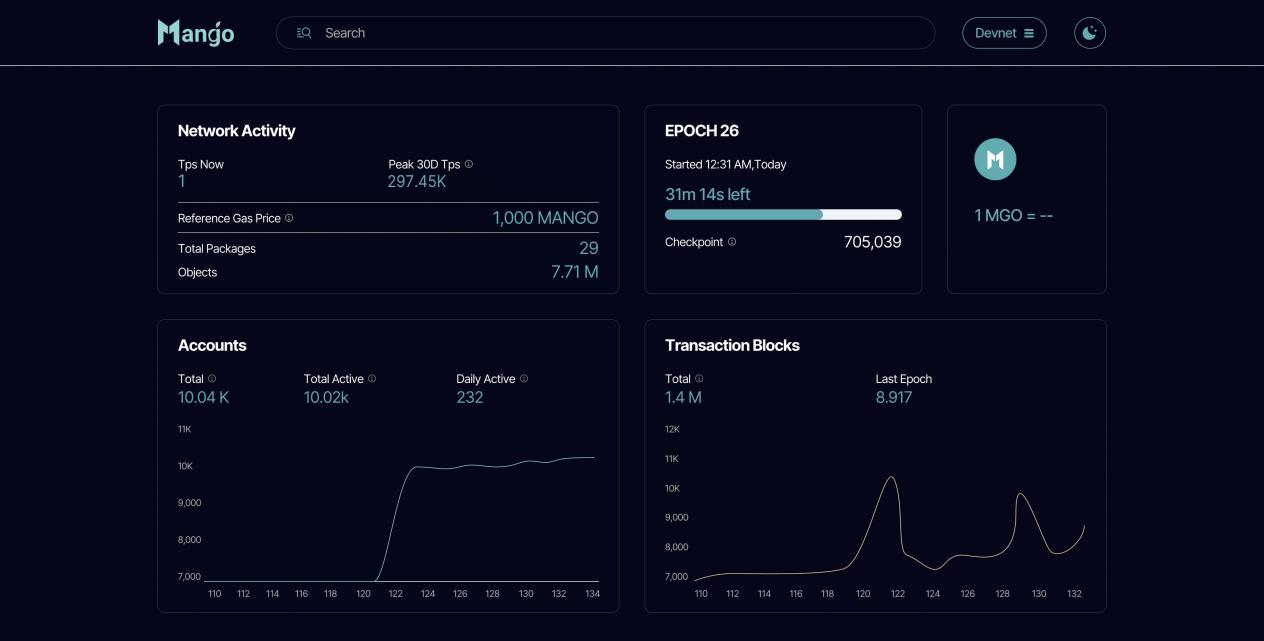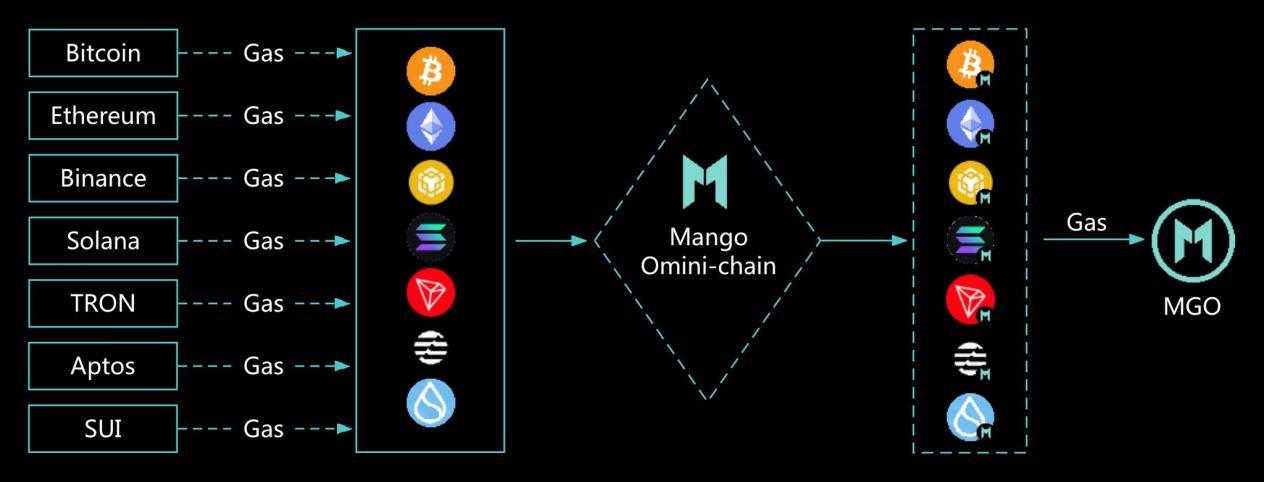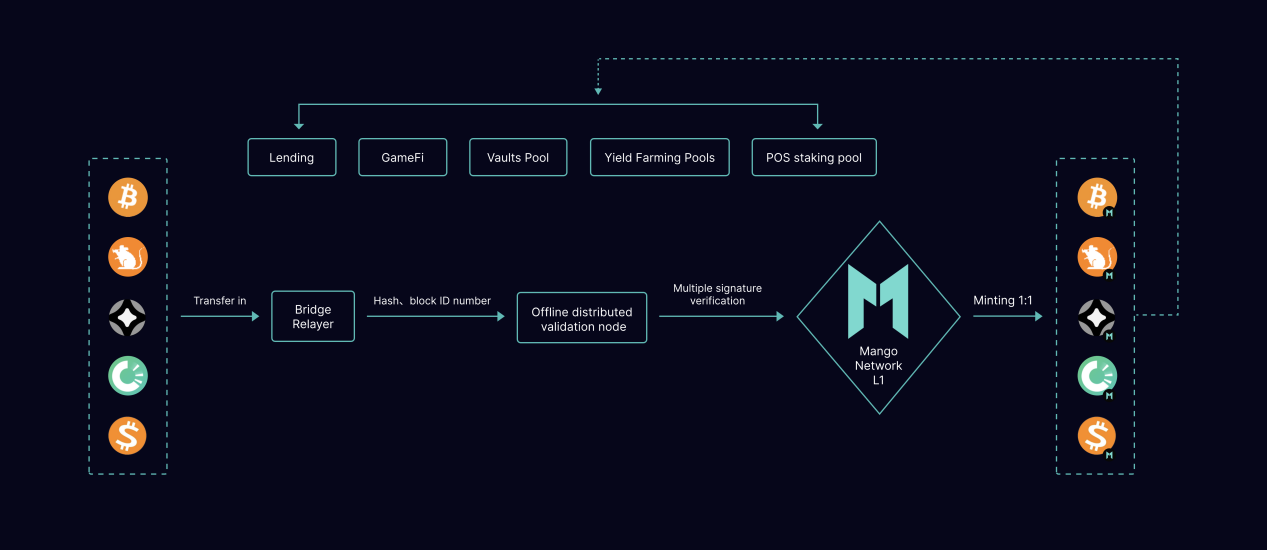Mango Network: Building a bridge for Bitcoin Layer 2 ecology, a better BTC native L2 bridge solution
As a transaction-based full-chain infrastructure network, Mango Network provides an innovative full-chain bridge protocol solution that can solve the Bitcoin network's problems in asset interest, transaction confirmation delays, lack of smart contracts, and high transaction fees. It also provides cross-chain interoperability for native assets such as Bitcoin, greatly expanding the ability of users to interact with various protocols. This breakthrough technological advancement, at a time when the Bitcoin Layer 2 ecosystem is heating up, has brought new vitality and opportunities to the cryptocurrency market.
Mango Network supports a series of Bitcoin protocols including BRC-20, BRC-420, Atomicals, Pipe, etc., which improves the liquidity and usability of Bitcoin assets in different blockchain ecosystems. This comprehensive compatibility makes Mango Network a key hub connecting Bitcoin with traditional smart contract chains such as Ethereum and its Layer 2 solutions, while also providing unprecedented smart contract functions for non-smart contract chains such as Bitcoin and Dogecoin, greatly expanding their application potential and market participation.
Mango Network's Layer 1 solution is strongly supported by the Move language, providing developers and users with a secure, modular and high-performance Web3 infrastructure. Its transaction processing speed is as high as 297,450 times (TPS), demonstrating excellent performance while maintaining a high degree of standardization, scalability and interoperability. This is particularly important in the current Bitcoin Layer 2 ecosystem, because with the rapid development of DeFi and other blockchain applications, the market demand for efficient and low-cost cross-chain solutions is growing.

Mango Network Devnet Up to 297.45 K TPS
With the support of Mango Network, users can freely transfer BTC assets to the Mango ecosystem and use them in various DeFi applications without worrying about the security of assets or the complexity of transactions. This seamless cross-chain experience not only provides new investment and income opportunities for Bitcoin holders, but also brings more innovation and growth potential to the entire blockchain industry.
Mango Network's cross-chain bridging capabilities enable it to connect multiple blockchains and layers, including the Ethereum mainnet, Layer 2 solutions, and Optimism Stack (such as Base). More importantly, Mango Network also supports non-smart contract chains such as Bitcoin, enabling unprecedented smart contract functions for these traditional chains, greatly expanding their application potential and market participation. In this way, Mango Network not only provides strong support for the cross-chain liquidity of Bitcoin assets, but also makes important contributions to the interoperability of the entire blockchain industry and the development of decentralized finance (DeFi).
1. What is Mango Network——A transaction-based full-chain infrastructure network, a comprehensive platform for full-chain interaction
As a transaction-based full-chain infrastructure network, Mango Network is a comprehensive platform that integrates Layer 1 blockchain and smart contract functions. It has built-in interoperability with various blockchains and layers. This unique feature enables it to achieve unified management of assets, data, and liquidity across different blockchain ecosystems. Mango Network's smart contract function is particularly suitable for blockchains such as Bitcoin that do not support smart contracts themselves. Through Mango Network, the assets of these chains can play a role in the Web3 field and realize value transfer.
2. Why Mango Network was created - to bridge the fragmentation of blockchain
The motivation for creating Mango Network stems from a deep understanding of the rapid expansion and fragmentation of the cryptocurrency industry. With the rise of applications such as DeFi, blockchain games, and social networking, new blockchains and layers continue to emerge to meet the demand for speed, flexibility, and low-cost transactions. However, such a diverse ecosystem also brings a series of challenges, including the complexity of cross-chain operations, security issues, and inconsistency in user experience.
Mango Network aims to solve these problems by providing a unified platform that allows users and developers to easily access and interact with different blockchain ecosystems. Through Mango Network, users can manage multiple crypto assets without having to set up separate wallets for each blockchain or layer, and there is no need to perform complex cross-chain operations. At the same time, Mango Network adds a new application dimension to traditional chains such as Bitcoin and Dogecoin by providing advanced smart contract functions, thereby promoting innovation and development in the entire industry.
Mango Network's full-chain technology principle is a highly integrated system designed to achieve seamless interoperability between different blockchains. The core of this technology is to provide a unified platform that allows assets, data, and smart contracts to flow and interact freely between multiple blockchain networks.

Mango Network full-chain technical schematic diagram
(1) Multi-chain compatibility: Mango Network has designed a set of protocols that are compatible with multiple blockchains and layers. It can identify and process transactions and assets from different blockchain networks such as Bitcoin, Ethereum, Binance Smart Chain, Solana, Tron, Aptos, Sui, etc.
(2) Cross-chain bridging: Mango Network uses cross-chain bridging technology to connect different blockchains. These bridges act as intermediaries, allowing assets to be transferred from one chain to another while keeping their value and attributes unchanged. Bridging technology is the key to achieving cross-chain transactions, which ensures the security and accuracy of asset transfers.
(3) Smart Contract Platform: Mango Network is not only a cross-chain bridge network, but also a smart contract platform. It allows developers to create and deploy smart contracts on Mango Network, which can be executed on different blockchains, thereby expanding the application scope of smart contracts.
(4) High-performance infrastructure: As a Layer 1 solution, Mango Network provides high-performance infrastructure. Its design supports high-throughput transaction processing, low-latency transaction confirmation, and efficient resource utilization, which are all necessary for modern blockchain applications.
(5) Security and decentralization: Mango Network adopts a series of security measures to protect the network and user assets. This includes encryption technology, multi-signature verification, offline distributed verification nodes, etc., ensuring the decentralization and anti-attack capabilities of the network.
(6) User-friendly interface: Mango Network provides an easy-to-use interface that allows users to easily conduct cross-chain transactions and manage assets. This design lowers the threshold for user participation and enables non-technical users to easily use blockchain services.
Through these technical principles, Mango Network aims to build a comprehensive blockchain ecosystem that supports cross-chain asset liquidity, promotes the development of DeFi and other blockchain applications, and provides users with a secure, efficient and convenient interaction platform.
3. How does the Mango Network full-chain protocol work?
The operation of the Mango Network full-chain protocol is based on a series of complex technologies and mechanisms, aiming to achieve interoperability and asset liquidity between different blockchains. The core components of the Mango Network full-chain protocol and how it works include:
(1) Multi-layer architecture: Mango Network is not just an underlying blockchain, it also acts as a functional layer that connects different blockchains together. This multi-layer architecture design enables Mango Network to interact with various blockchains and layers to achieve cross-chain flow of assets and data.
(2) Multi-signature verification nodes: Mango Network uses offline distributed verification nodes to monitor and confirm events on external chains, such as transfers. These nodes can operate independently without a real-time network connection and ensure the authenticity of events by reaching consensus. Once consensus is reached, these nodes will sign and confirm these events to the chain to which they are connected, thereby ensuring the security and consistency of cross-chain transactions.
(3) Full-chain smart contracts: Mango Network’s full-chain smart contracts are responsible for processing events from external chains. These smart contracts can read data from external chains, execute corresponding logic, and return the results to the external chain. As the only source of authenticity, full-chain smart contracts ensure that the status of assets and data remains consistent regardless of which chain they are located on.
(4) Cross-chain message transmission: Mango Network allows smart contracts to send data and value between different chains and layers through a cross-chain message transmission mechanism. This process usually involves calling a unique identifier on the chain, such as a transaction hash or block ID number. In this way, smart contracts on the current chain can communicate with Relayers on different chains to achieve cross-chain transmission of assets and data.
Mango Network's full-chain protocol achieves seamless connection between different blockchains through these mechanisms, providing a solid foundation for asset liquidity and cross-chain applications. This design not only improves the efficiency and security of transactions, but also provides developers and users with a more flexible and convenient cross-chain interaction experience.
4. Bridge security is critical
Mango Network has carefully designed a package of security measures to ensure bridge security.
First, it uses offline distributed verification nodes that independently verify transactions without being directly connected to the network. This means that even if the network is attacked, these nodes can still maintain the integrity and security of transactions.
The multi-signature verification mechanism is another key component of Mango Network's security. This mechanism requires multiple independent signatures to confirm transactions, increasing resistance to potential fraud. In Mango Network, transactions can only be processed after consensus confirmation by multiple verification nodes, which ensures the security and decentralization of the network.
In addition, Mango Network's decentralized proof-of-stake network further enhances security. In this network, no node can know or control the private key alone. This design ensures the security of the private key and prevents the risk of private key leakage or abuse.
Mango Network full-chain bridge protocol signs and holds assets in native form, which means that assets always maintain their original state during the transfer process and will not be replaced or tampered with. At the same time, idle funds will never be threatened.
Mango Network's bridge protocol provides a highly secure environment through offline distributed verification nodes, multi-signature verification mechanisms, and decentralized proof-of-stake networks, ensuring the secure transmission of data and value. These measures together form the security foundation of Mango Network's bridge, making it a cross-chain solution that users and developers can trust.
The uniqueness of Mango Network - full-chain technology architecture
Mango Network is unique in its innovative full-chain technology architecture. It is not only a high-performance Layer 1 platform that provides high-speed transaction processing and rich smart contract functions, but also enables seamless connection with multiple blockchain networks, including non-smart contract chains. Through its advanced cross-chain bridging protocol and multi-signature verification mechanism, Mango Network greatly enhances asset liquidity and interoperability while ensuring the security and decentralization of transactions. This allows Mango Network to become a key force in promoting the development of Web3 and the expansion of the cryptocurrency market.

BTC Bridge Technology Operation Principle
The above diagram shows the operating principle of Mango Network’s BTC Bridge technology, which is a cross-chain bridging mechanism used to enable the transfer and use of Bitcoin (BTC) assets in Mango Network. The following is a logical overview of the mechanism:
(1) Asset transfer: The user first sends the BTC asset to the Bridge Relayer address, which is a dedicated smart contract address used to receive and process cross-chain transferred BTC.
(2) Offline distributed verification: After receiving BTC, the Bridge Relayer locks the assets and performs multiple verifications. This step involves offline distributed verification nodes, which verify and reach consensus on the transfer of BTC without relying on real-time network connection.
(3) Multi-signature verification: In order to ensure the security of transactions, Mango Network adopts a multi-signature verification mechanism. This means that multiple independent signatures are required to confirm the transfer of BTC, thereby improving security.
(4) Minting 1:1-MBTC: Once BTC is successfully locked and verified, Mango Network will mint an equal amount of MBTC (Mango Bitcoin Token), which is the equivalent token of BTC in Mango Network. This process ensures the authenticity and consistency of the value of the assets.
(5) Asset distribution: The minted MBTC will be sent to the user's Mango Network wallet. Users can use these MBTC for lending, participation in GameFi, machine gun pools, liquidity pools, POS staking pools and other applications in the Mango ecosystem.
(6) Relayer’s role: Throughout the process, Relayer is responsible for transmitting transaction information and asset status between different chains of Mango Network. Relayer ensures the accuracy and timeliness of cross-chain communication.
(7) Interaction between Layer 1 and Layer 2: As a Layer 1 blockchain, Mango Network provides basic security and decentralization. At the same time, it can also interact with Layer 2 solutions (such as Optimism, Arbitrum, etc.), further expanding the application scope of BTC assets.
Through this cross-chain bridging mechanism, Mango Network realizes the liquidity and availability of BTC assets in different blockchain ecosystems, providing users with a wider range of application scenarios and investment opportunities.
With the support of the Mango network, users can freely transfer BTC assets to the Mango ecosystem and use them in various DeFi applications without worrying about the security of assets or the complexity of transactions. This seamless cross-chain experience not only provides new investment and income opportunities for Bitcoin holders, but also brings more innovation and growth potential to the entire blockchain industry.
The underlying architecture of the Mango network provides the necessary security, performance and interoperability for these applications, ensuring that the control of user assets is always in the hands of users, while providing an efficient and low-cost transaction experience. The Mango network will become a key platform for promoting the development of Web3 and realizing the widespread application of blockchain technology, allowing all participants to enjoy unprecedented freedom and flexibility in the Web3 world.
Mango Network official
1. Web: https://mangonet.io
2.X: https://twitter.com/MangoOS_Network
3.Mail: BD@mangonet.io
Mango Network Dve
1. Blockchain Browser: https://mgoscan.com/
2. Github: https://github.com/MangoNet-Labs
3.GitHub open source: https://github.com/MangoNet-Labs/mango
4. Developer Documentation: https://docs.mangonet.io/
5.Swap interactive application: https://swap.devnet.mangonetwork.io/swap



